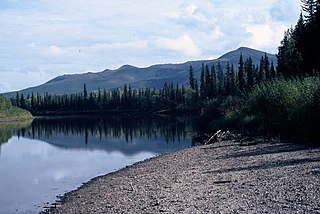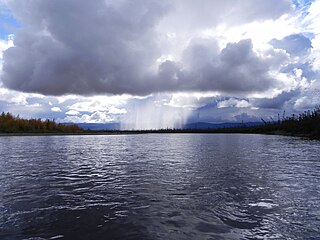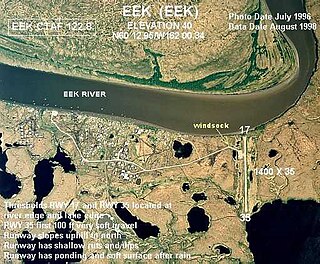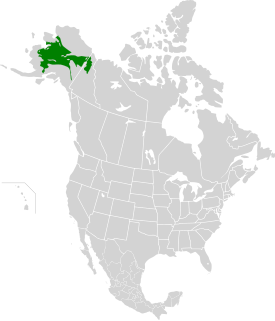| Hodzana River | |
|---|---|
| Country | United States |
| State | Alaska |
| Census Area | Yukon–Koyukuk |
| Physical characteristics | |
| Source | southern flanks of the Brooks Range |
| - location | west of Dall Mountain on the Arctic Circle |
| - coordinates | 66°29′32″N150°02′59″W / 66.49222°N 150.04972°W [1] |
| - elevation | 3,196 ft (974 m) [2] |
| River mouth | Hodzana Slough of the Yukon River [1] |
| - location | 12 miles (19 km) southwest of Beaver, Yukon Flats National Wildlife Refuge |
| - coordinates | 66°17′30″N147°46′23″W / 66.29167°N 147.77306°W Coordinates: 66°17′30″N147°46′23″W / 66.29167°N 147.77306°W [1] |
| - elevation | 335 ft (102 m) [1] |
| Length | 125 mi (201 km) [1] |
The Hodzana River is a 125-mile (201 km) tributary of the Yukon River in the U.S. state of Alaska. [1] The Yukon Flats National Wildlife Refuge covers a large part of the river basin. [3]

The Yukon River is a major watercourse of northwestern North America. The river's source is in British Columbia, Canada, from which it flows through the Canadian Yukon Territory. The lower half of the river lies in the U.S. state of Alaska. The river is 3,190 kilometres (1,980 mi) long and empties into the Bering Sea at the Yukon–Kuskokwim Delta. The average flow is 6,430 m3/s (227,000 ft3/s). The total drainage area is 832,700 km2 (321,500 mi2), of which 323,800 km2 (126,300 mi2) is in Canada. The total area is more than 25% larger than Texas or Alberta.

In the United States, a state is a constituent political entity, of which there are currently 50. Bound together in a political union, each state holds governmental jurisdiction over a separate and defined geographic territory and shares its sovereignty with the federal government. Due to this shared sovereignty, Americans are citizens both of the federal republic and of the state in which they reside. State citizenship and residency are flexible, and no government approval is required to move between states, except for persons restricted by certain types of court orders. Four states use the term commonwealth rather than state in their full official names.

Alaska is a U.S. state in the northwest extremity of North America, just across the Bering Strait from Asia. The Canadian province of British Columbia and territory of Yukon border the state to the east and southeast. Its most extreme western part is Attu Island, and it has a maritime border with Russia to the west across the Bering Strait. To the north are the Chukchi and Beaufort seas—southern parts of the Arctic Ocean. The Pacific Ocean lies to the south and southwest. It is the largest U.S. state by area and the seventh largest subnational division in the world. In addition, it is the 3rd least populous and the most sparsely populated of the 50 United States; nevertheless, it is by far the most populous territory located mostly north of the 60th parallel in North America: its population—estimated at 738,432 by the United States Census Bureau in 2015— is more than quadruple the combined populations of Northern Canada and Greenland. Approximately half of Alaska's residents live within the Anchorage metropolitan area. Alaska's economy is dominated by the fishing, natural gas, and oil industries, resources which it has in abundance. Military bases and tourism are also a significant part of the economy.
Beginning west of Dall Mountain just south of the Arctic Circle, the river flows northeast into the wildlife refuge, then southeast to Hodzana Slough, an arm of the Yukon. [3] The river mouth is 12 miles (19 km) southwest of Beaver, [1] a village further up the Yukon. [3]

The Arctic Circle is one of the two polar circles and the most northerly of the five major circles of latitude as shown on maps of Earth. It marks the northernmost point at which the centre of the noon sun is just visible on the December solstice and the southernmost point at which the centre of the midnight sun is just visible on the June solstice. The region north of this circle is known as the Arctic, and the zone just to the south is called the Northern Temperate Zone.
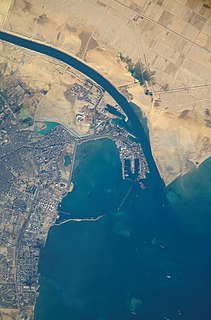
A river mouth is the part of a river where the river debouches into another river, a lake, a reservoir, a sea, or an ocean.

Beaver is a census-designated place (CDP) in Yukon-Koyukuk Census Area, Alaska, United States. At the 2010 census the population was 84, unchanged from 2000.



